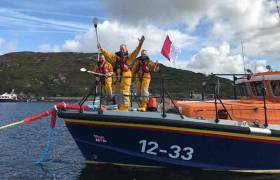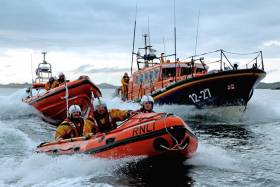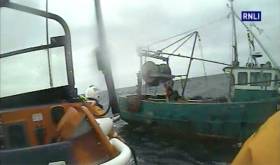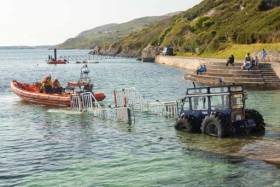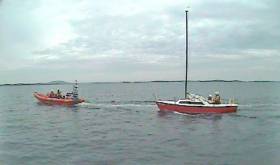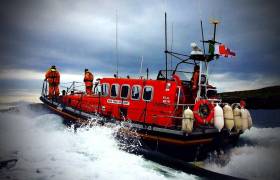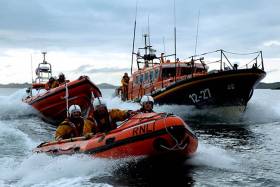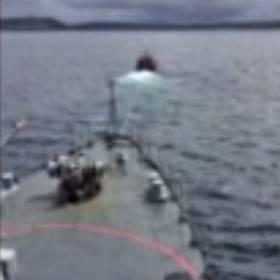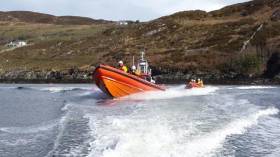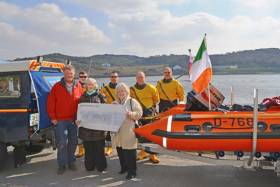Displaying items by tag: Clifden
Clifden RNLI Hoping for Galway Double as All-Weather Lifeboat Gets Go-Ahead
Volunteer lifeboat crew at Clifden RNLI are celebrating the news that their all-weather lifeboat is to be permanently allocated at the Connemara lifeboat station following a successful trial which has seen 50 launches by the lifeboat crew and 32 people rescued or assisted. They are now hoping that their good luck rubs off on their fellow countymen this weekend and that the Galway hurlers bring home the Liam MacCarthy cup.
The RNLI and the GAA have announced a major partnership this year for the charity’s Respect the Water drowning prevention campaign aimed at sharing lifesaving advice and information through the sporting organisation’s clubs. In celebrating their good news, lifeboat crew from Clifden RNLI proudly flew the Galway colours in support of the county’s hurlers who are due to play Waterford in the All Ireland final.
The volunteer lifeboat crew first took ownership of an all-weather lifeboat in August 2014 when the Pride and Spirit was officially put on service and became a declared search and rescue asset for a trial period. The lifeboat operated alongside the two inshore lifeboats at the station. The decision followed an in-depth review of lifeboat cover in the area.
John Brittain, Clifden RNLI Lifeboat Operations Manager confirmed that the station had received word from the RNLI Trustees that the trial had been a success and the lifeboat will be made permanent.
‘The all-weather lifeboat has enabled us to provide lifesaving cover in all weathers up to 100 miles off the Connemara coast and it has complemented our inshore lifeboat service. During the trial period the all-weather lifeboat has enabled us to assist in and complete medical evacuations from the island of Inishbofin and Inishturk as well as providing assistance to a variety of boats and people in distress.
‘I would like to commend the dedication of our volunteer crew members here in Clifden who have devoted their time to ensure the period of change and training was a success. It is thanks to their efforts that we are now able to provide this service permanently to the Connemara community and to anyone who may find themselves in distress at sea.’
#RNLI - Clifden RNLI launched their inshore and all-weather lifeboats on Tuesday night (27 July) to reports of a pleasure boat in difficulty east of Davillaun Island.
The eight people on board had been to Inishbofin for the day and were returning home when the weather turned, becoming wet and foggy.
The volunteer lifeboat crew was requested to launch by Malin Head Coast Guard at 6.58pm to assist the broken down pleasure craft.
Once the Atlantic 85 inshore lifeboat was on scene, one of the RNLI crew boarded the pleasure boat to assist the casualties and to secure a tow line.
Four of the casualties were then transferred onto the lifeboat where they received casualty care while the remaining four people stayed on the pleasure boat as it was towed towards the pier at Aughris, over an hour away.
When the Mersey class all-weather lifeboat arrived, all eight casualties were put on board and taken inside to warm up. The RNLI crew also radioed ahead to request an ambulance to meet them at Aughris as one of the group required further medical attention.
The casualty was assessed by paramedics and transferred to hospital for further treatment. The remaining seven people disembarked the lifeboat at the pier.
“This callout shows how conditions can change quite quickly at sea,” said Clifden RNLI lifeboat helm Daniel Whelan. “Visibility became poor as the weather deteriorated. Thankfully we have a fast responding Atlantic 85 lifeboat and a well-trained crew. Having the all-weather lifeboat provide cover was invaluable, providing warmth and comfort for the casualties.
“Safety at sea is so important. Wear plenty of layers. Tell someone your plan and bring a suitable form of communication. The group in trouble did all of this which made it much easier to locate them.”
Clifden RNLI coxswain David Barry added: “This was a very successful callout with both lifeboat crew working well together to bring the casualties to safety. It was a beautiful day but the weather turned as the evening approached. We wish the patient a speedy recovery.”
Clifden Lifeboat Rescues Fisherman Off Slyne Head
#RNLI - Clifden RNLI’s all-weather Mersey Class lifeboat Fisherman's Friend was launched at 1.30pm on Saturday (1 July) to go to the assistance of a fishing vessel adrift six miles off Slyne Head in Co Galway.
The 11m vessel had been en route from Baltimore to Blacksod before it suffered engine problems in challenging weather conditions, with a 2m swell and Force 6 wind blowing from the north west.
The skipper requested some water to try and get his engine going again. The lifeboat crew assisted, and this initially solved the problem. However, the engine soon stalled again, and the lifeboat crew proceeded to establish a towline.
At 3.30pm the vessel was put under tow and returned to Clifden Bay. The tow took just over two hours to complete.
Speaking following the callout, coxswain John Mullen said: “We dropped the skipper off on the visitor’s moorings in Clifden Bay with the assistance of the inshore D Class lifeboat.
“It was a good call out for the all-weather lifeboat in challenging conditions. We would like to wish the fisherman well and thank all the crew involved.”
Two Medevacs For Clifden Lifeboat Since Friday
#RNLI - Clifden RNLI has carried out two medical evacuations from the island of Inishbofin off Connemara since Friday (23 June).
The pagers first sounded at 11.15am on Friday in response to a call for the medevac of an elderly woman in need of hospital treatment.
Clifden's D Class inshore lifeboat and crew were already on the water in Clifden Bay carrying out a scheduled exercise when they were called to transfer to the Atlantic 85, helmed by Joe Acton, that arrived at the island before the Irish Coast Guard helicopter Rescue 118, which was also tasked.
Lifeboat crew member Sinead Pryce assisted the casualty, and the lifeboat and helicopter worked together to ensure a seamless transfer.
The following morning (Saturday 24 June), pagers once again sounded shortly after 7.15am after a woman on Inishbofin had become suddenly unwell.
The all-weather boat Fisherman’s Friend was requested to respond and a crew was assembled including coxswain Alan Pryce, mechanic Robert King, navigator Owen Hayes and crew Brian Ward and Neil Gallery.
The casualty was transferred to the all-weather boat by the crew and island nurse and taken to Cleggan Pier where an ambulance was waiting.
Speaking following the callouts, Clifden RNLI lifeboat operations manager John Brittain said: “It has been a busy summer week for the Clifden lifeboats with three launches taking place involving our different boats in different scenarios.
“I want to thank the crew for responding to their pagers promptly in these cases so that we can continue to carry out this vital service in our local community.”
Clifden, Union Hall Lifeboats Launch To Yachts In Difficulty
#RNLI - Clifden RNLI prepared for launch at 7.16pm on Tuesday evening (20 June) to assist a yacht gone aground in the Clifden Bay area.
Helm David Barry, along with volunteer crew Ian Shanahan, Brian Ward and Owen Hayes on the Atlantic 85 inshore lifeboat, quickly located the 23ft yacht stranded on a rocky piece of shoreline.
The lone sailor on board was uninjured, and after communication with the lifeboat crew, it was agreed to tow the yacht from its location.
Clifden’s all-weather lifeboat and the Rescue 118 helicopter from Sligo were also requested to assist, but both were stood down when the yacht was successfully under tow.
Speaking following the callout, Barry said: “We returned the sailor and his yacht to a mooring in Clifden Bay and were glad to have been able to respond so quickly to a vessel in need of assistance.”
Meanwhile in West Cork, Union Hall RNLI were requested at 8.32pm to provide assistance to a 21ft yacht with two people on board, seven-and-a-half miles south of Adam Island at the entrance to Glandore Harbour.
The Union Hall inshore lifeboat Margaret Bench of Solihull launched within seven minutes and headed to the yacht, where sea conditions were calm but the yacht had encountered a squall, which resulted in the loss of a sail and instruments.
The lifeboat volunteers made contact with the two people on board, ensured there was no injuries, attached a tow line and towed the yacht back to the safety of Union Hall Pier.
Speaking after the callout, Union Hall RNLI lifeboat operations manager John Kelleher said: “The crew of the yacht made the right decision to contact the coastguard sooner rather than later.
“Always carry a means of communication, be it VHF or mobile phone. It is very important, especially at nighttime.”
Clifden Lifeboat Assists In Medevac From Inishturk
#RNLI - An island medical evacuation was carried out yesterday (Monday 26 September) by the volunteer crew of Clifden RNLI on the Mersey class all-weather lifeboat Fisherman's Friend.
In calm seagoing conditions, the lifeboat was launched at 1.15pm to attend to a man who had experienced a fall at the north end of Inishturk off the Mayo coast.
On arrival at the pier in Inishturk, the casualty was taken aboard the lifeboat and transferred to Cleggan pier, where he was moved to a waiting ambulance with the assistance of the Cleggan Coast Guard Unit.
Speaking following the callout, Clifden RNLI coxswain Alan Pryce said: “We were glad to be able to transfer this man safely to shore and we wish him a speedy recovery.
“The capability of the all-weather lifeboat in carrying out long-range shouts such as this one is reassuring, both for us as volunteers and all those who live on and visit our offshore islands.”
Six Rescued in Two Separate Call Outs for Clifden RNLI
Clifden RNLI rescued six people in two separate call outs off the Connemara coast last week.
On Friday afternoon, the volunteer lifeboat crew was requested to launch their all-weather and inshore Atlantic 85 class lifeboats following a report that two people were in the water after their 6ft boat had ran aground and hit rocks.
The lifeboat helmed by Joe Acton and with crew members Dermott Clancy, Alvin Bell and Kenneth Flaherty onboard, launched within minutes and made its way to the scene on the south east side of Davillaun.
With a report that two people had entered the water, the Irish Coast Guard’s helicopter Rescue 118 from Sligo was also tasked and a pan-pan was put out to all vessels in the area to assist in the operation.
Weather conditions at the time were described as dry but blowing a Force 5-6 gale with a choppy sea and a good ground swell.
Clifden’s inshore lifeboat was the first vessel to arrive on scene where the crew observed that the two men had managed to get themselves on the rocks. They were cold and wet and holding on to their boat to keep it afloat.
Lifeboat crew member Alvin Bell was put onto the rocks where he assessed the casualties and ensured they were ok. With no injuries sustained he then proceeded to help them on to the lifeboat where they were further assessed and made comfortable. A towline was then set up and the casualty vessel was pulled off the rocks and brought alongside the lifeboat to prevent further damage.
Following an hour long tow, the two men and their vessel were brought safely back into Derryinver Pier.
Earlier in the week, the lifeboat was called upon on to assist the crew of a 35ft trawler that had got into difficulty on Clifden Bay.
The Atlantic 85 inshore lifeboat was requested to launch at 11.30am on Tuesday (23 August) after gear got tangled in the prop of the trawler resulting in no steerage and no propulsion.
The lifeboat helmed by Joe Acton and with crew members Alvin Bell, Kenneth Flaherty and Eoin Hayes onboard, made its way to scene where they worked with the four crew onboard to set up a towline.
Weather conditions were good with a flat calm sea. However, with the boat running against the tide, helm Joe Acton called on the assistance of Clifden’s D class inshore lifeboat which on arrival helped with the safe manoeuvre of the trawler into the quay at Clifden.
Speaking following the two call outs, Clifden RNLI helm Joe Acton said: ‘We were happy to be of assistance on both occasions last week. Friday’s call out was a bit more challenging following the initial report that two people were in the water but thankfully they had managed to make it on to rocks where they were waiting safe and well if not cold and wet following their ordeal.
‘We would encourage anyone taking to the sea for work or pleasure, to enjoy it but to always respect the water. Always wear a lifejacket and carry a means of calling and signalling for help. Always check the weather forecast and tide times. Make sure someone ashore knows where you are going and who to call if you don’t return on time. Learn how to start, run and maintain your engine before taking to the water.’
Clifden Lifeboat Tows Naval Vessel In Training Exercise
#RNLI - An unusual training exercise took place on Sunday (14 August) off the Connemara coastline involving the Naval Service vessel LÉ Orla and the volunteer crews of the Clifden RNLI lifeboats.
In calm conditions, RNLI volunteers and naval crew co-operated on a number of training exercises, beginning with a 'man overboard' scenario, in which the casualty was transferred by hoist from the LÉ Orla to the Mersey class all weather-lifeboat Fishermans Friend.
A RIB from the naval vessel was then recovered in the water and towed by the Atlantic 85 lifeboat helmed by Daniel Whelan with crew John Mullen, Gerry Claffey and Michael Carey.
Next up was a salvage operation exercise, where the lifeboat crew used their salvage pump onboard the Naval vessel which was supposedly adrift at the time.
"It was at this point it occurred to me that as part of a salvage operation we would normally tow the vessel in question," said Clifton RNLI coxswain David Barry, who requested and was granted permission to tow the 750-tonne OPV at 1,500 revs and 3.2 knots.
"Admittedly, conditions were very calm at the time, but we were all really delighted to have been able to successfully carry out a brief tow," he added. "In poorer conditions, we might have been able to at least keep the ship nose to sea.
"Overall, the day's exercises were a huge success for the whole crew and we are really grateful to the Irish Naval Service for facilitating these invaluable exercises."
To round off the exercise session, three Naval Service divers were recovered from the water by both lifeboats.
Since the introduction of the all-weather lifeboat to Clifden, the volunteer crew have undertaken many hours of advanced and innovative exercise scenarios intended to give the crew experience and competence.
East Meets West As Skerries Lifeboat Crew Visits Clifden
#RNLI - Skerries RNLI's volunteer crew headed to the West of Ireland this month as they paid a visit to their colleagues in Clifden RNLI.
Once a year the volunteers in Skerries undertake a team-building and fact-finding trip to other rescue services and lifeboat stations.
Despite being located on opposite sides of the country, Skerries RNLI and Clifden RNLI had previously exercised together, along with Clogherhead RNLI, off the East Coast back in 2014.
On that occasion the Clifden crew were being trained on the Mersey-class all-weather lifeboat that the station took on for a 12-month trial.
Last Saturday (16 April), Clifden RNLI launched all three of their lifeboats – a Mersey-class, an Atlantic 85 inshore lifeboat and a D-class inshore lifeboat – to take the volunteers from Skerries afloat and give them a taste of the challenges they faced on the West Coast and at their own station in particular.
Skerries RNLI would like to thank volunteers Philip Ferguson and Laura Boylan for organising the trip; Irish Rail, who very generously subsidised the travel costs; and most importantly all, the volunteers at Clifden RNLI for giving up their time and extending a warm welcome.
Speaking about the exercise, Skerries RNLI volunteer lifeboat press officer Gerry Canning said: "It’s always a great learning experience for our volunteers to see the challenges that face other crews around the coast, and how they deal with them.
"The guys from Clifden RNLI were fantastic and really pulled out all the stops to make sure we went afloat and got a good insight into why they require each of their boats."
Sun Shines On St Patrick's Day Donation To Clifden Lifeboat
#RNLI - Bright sunshine and a much appreciated donation was a great start to St Patrick’s Day for the crew of Clifden RNLI.
Longtime supporters and fundraisers Jacqueline Hannon and Nancy Duffy of Claddaghduff, Co Galway presented a cheque for €1,820 to the Clifden volunteer lifeboat crew, the proceeds of a Christmas concert and fundraising event held in Joyce’s Bar in the fishing village of Cleggan on 16 December.
John Brittain, Clifden RNLI Lifeboat Operations Manager said: "We are really delighted to welcome Jacqueline and Nancy to Clifden station once again and would like to thank them most sincerely for the hard work and organisation of this fantastic fundraiser.
"Special thanks also to the people of Cleggan and Claddaghduff who generously supported the event."
After the cheque presentation, the volunteer crew participated in both the Clifden and Roundstone annual St Patrick’s Day parades.


























